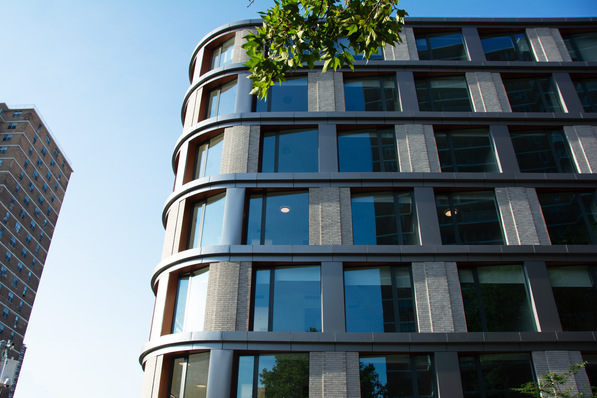GW-News: How can safety and aesthetics be reconciled in glass and for which projects is this relevant?
Sebastian Dengg: Take listed buildings: In many cases, it is necessary to preserve the existing building envelope, but at the same time to meet the demand for maximum mechanical security against bullets and burglary by means of security glazing.
In such cases, the architecture must not be impaired by the security requirements. This can be the case with listed government buildings, museums or a shop facade, as well as with a private property. Everywhere, where no massive constructions are to be used without consideration of the appearance.
See also: What makes XXL glazing safe?
Planners and glass suppliers have to find individual, sometimes highly complex solutions that combine all the requirements of the building owner. But this is feasible.
GW-News: What are clients looking for and what do planners and architects want?
Architects usually want a combination of safety and aesthetics. The top priority is a harmonious overall appearance, i.e. the security measures must not impair the aesthetic effect of the building. Planners often want the integration of innovative technology that offers enhanced security. And private building owners often express the wish that they do not want to be reminded of their need for protection when looking out of their panorama window.
GW-News: Is it possible to combine all these requirements?
Yes, it is possible to achieve a high level of security without it being visible. In recent years, the demand for burglar-proof and bullet-proof security glass has increased significantly. Nevertheless, they should be as visually unobtrusive as possible. This can only be achieved with a coordinated security concept that integrates all the glass used and that takes into account the circumstances on site.
GW-News: What does this concept have to include as a minimum, what can it include as a maximum?
The basis of the concept is a so-called GAP analysis, in which the existing situation and the desired level of security are compared to determine possible gaps. Based on this, proposals for constructive measures are worked out and discussed with those involved in the project. This determines whether partial areas can be strengthened with relatively little effort or whether complete facade assemblies must be replaced. The GAP analysis is therefore the basis for determining the cost of the safety measures. Experience shows that usually not only the glass itself, but also its connection to the frame system is a major weak point that needs to be solved.
GW-News: What does the implementation look like?
This is usually complex and requires a lot of intuition. In addition to the expert's or security consultant's profound understanding of mechanical safety and security glass, production processes and a feeling for aesthetics, creative solution concepts are often required to make a building safe and appealing. A holistic approach is essential, especially when the entire security system needs to be retrofitted.
GW-News: We have talked about refurbishment, what about security systems for new buildings?
Modern materials and new security systems allow for discreet and elegant constructions. There are a number of tested security glazing systems on the market today that have a delicate design. The resistance classes RC2 and RC3 are already virtually a matter of course. However, resistance class RC4 is no longer so common. The leap from RC3 to RC4 is relatively large and requires much more effort.
GW-News: Why is that the case?
With RC4 requirements, the system of safety glass, glass connection, frame, locking technology, etc. is considered very comprehensively and, according to legal requirements, must be constructed very coherently in itself. This makes it all the more challenging to retrofit existing constructions to such an extent that it corresponds to a tested system of resistance class RC4.
GW-News: Can you give some examples?
Using the example of a glass facade in an existing building, it is first necessary to check the technical possibilities of the frame construction to accommodate new safety glass. What resistance class is required and what glass thicknesses and weights can the frame accommodate? The static limits of the construction are the decisive factor here. In addition, aspects of building physics play an important role. Once the initial situation has been determined, the task is to find a suitable glass or to develop it specifically for the project. Once this has been successfully solved, however, it is not enough to simply insert the new safety glass into the existing frame: In addition to many possible scenarios, it must not be possible to break it out of the frame, for example, and the glass connection must offer sufficient resistance to break-in attempts.
GW-News: What is this effort based on?
With RC4, you assume an experienced professional who plans his crime carefully, i.e. not an opportunistic offender who takes flight at the first resistance. Therefore, the entire security glass system with all its details must be finely tuned, from the glass (+ installation) to the frame to the connection to the masonry.
The interview was conducted by Matthias Rehberger
Who is Sebastian Dengg?
The expert for mechanical safety glass systems has over 20 years of experience in consulting and developing such systems.














